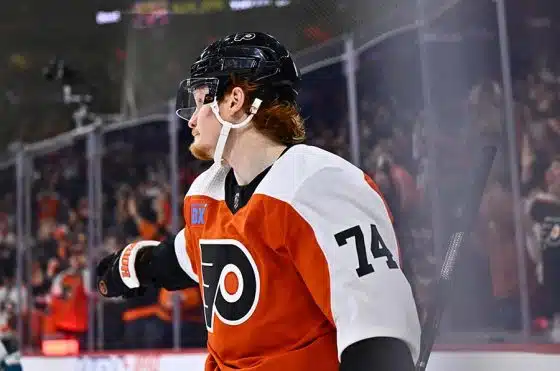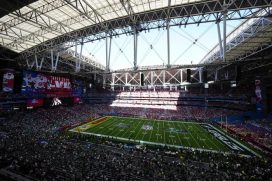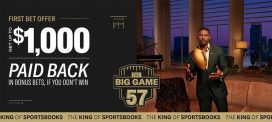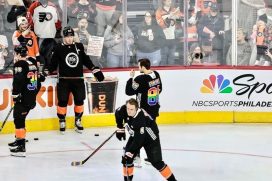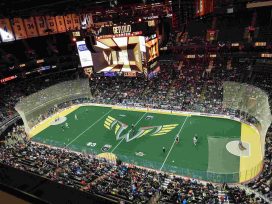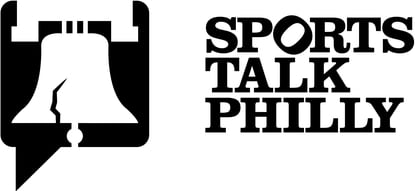Patrick Causey, on Twitter @pcausey3
Every year, certain players become undervalued by NBA circles. Whether it be their age, shooting ability, or some other defect that hangs over their head like a dark cloud, these otherwise talented players drop past the point at which their value demands they be drafted.
This year, at least three players come to mind: Kris Dunn, Brice Johnson, and Patrick McCaw.
For the Sixers, Johnson and McCaw are surprisingly, and laughably, in play at 24 and 26, despite talents that suggest they should be considered as borderline lottery picks. If either are available, the Sixers should jump at the opportunity to draft them.
But if the Sixers want any chance of landing Dunn, they must unload one of the big men that they stockpiled under Sam Hinkie — presumably Jahlil Okafor — to get back into the top 8 of the draft. It is a price I am willing to pay, because I think Dunn is a difference maker at the next level.
Let's break down why I am such a fan of these players, and why I think they would be great fits for the Sixers.
Kris Dunn
So how is a guy pegged as a lock to go in the top 8 of the draft considered underrated? Because I think Dunn is the third best prospect in this draft, and would not be surprised if he ends up with a better career than Brandon Ingram, the presumptive number two pick.
Simply put, Kris Dunn plays like his hair is on fire. Blessed with exceptional speed and agility, Dunn is a menace on both ends of the floor. His otherworldly athleticism is matched only by his obsessive competitiveness, which is on full display no matter if it's practice or Game 7 of the NBA Finals. That bulldog mentality is the perfect tone setter for a young team like the Sixers that is bereft of talent. His demeanor, his attitude, his intensity, will bleed over to his teammates on a nightly basis.
My favorite anecdote of Kris Dunn came courtesy of Derek Bodner of PhillyMag.com. According to Bodner, Dunn isn't hosting private workouts for teams unless they are willing to let him match up against other top guard prospects in this draft, like Buddy Hield or Jamal Murray.
It'll never happen. But I still love it. It tells me that Dunn is aware of his own flaws. For a guy that struggles at times with his shot, there is little to gain from a workout that largely consists of shooting drills on the perimeter. But it also speaks to the competitive fire and inner confidence I mentioned earlier. Dunn just knows that if a team lets him match up one-v-one against Murray or Hield he will outperform them both.
How can you not love that — especially on a team like the Sixers that will be struggling to find its way for the next three-plus seasons?
But let's take a step back from the intangibles for a moment. Dunn was a stat-stuffer last year, averaging 16.4 points, 6.2 assists, 5.3 rebounds, 2.5 steals, while shooting 47% from 2, 37% from 3, and a true shooting percentage of 54%.
Perhaps most impressively, Dunn assisted on 41.8% of his teammates points while he was on the court, according to Sports-Reference.com. For comparisons sake, Ben Simmons was at 27.4%, Brandon Ingram: 11.4%, Jamal Murray: 12.1% and Buddy Hield at 12.7%. In other words, Dunn kind of knows how to generate scoring opportunities for his teammates.
In terms of physical attributes, Dunn's calling card is his freakish athleticism, even by NBA standards. Dunn just has another gear that few players in the league posses, and it is most evident when he is able to get out in transition:
For my money, Dunn is slightly behind Russell Westbrook and John Wall athletically, but that still puts him among the elite of the elite in the NBA.
Dunn's athleticism extends beyond straight-line speed, as he possess the quick twitch explosiveness that can be devastating in the half court setting, particularly on pick and rolls:
His 6.5 rebounds per 40 minutes illustrates how Dunn uses his athleticism to his advantage and mitigate the concerns presented by his inconsistent J. He is constantly on the move, constantly attacking, constantly putting pressure on the defense. Dunn can be the glue guy that does all the dirty work and be one of the best players on the team. That has tremendous value.
But there were many instances where his gambles failed to payoff, and Dunn's aggressiveness left his team hanging.
There are three primary concerns with Dunn that are holding him back from being a lock at #3: his age (he's 22), propensity for turnovers (he averaged 3.5 turnovers per game), and shooting. The age concern tends to be overblown. Dunn didn't stay in college because he was an average prospect that needed more time to improve his draft stock. He stayed four years because he lost his first two seasons due to injuries.
But the turnovers and shooting are legitimate concerns. 3.5 turnovers per game, which grades out to 4.3 turnovers per 40 minutes, is stupid high.
Some of this is correctable, some of it isn't. Dunn was one of the only playmakers on Providence — indeed, at times he was the offense — so he had a tendency to try to play herbal too much, which led to turnovers. But Dunn also showed a propensity for making bad decisions, decisions which he must reduce if he is going to max out his potential.
Dunn shot 37% from three last season, which masks his consistency issues. Dunn is a streaky shooter, with bouts of high percentage production followed by shots that awkwardly clank off the side of the backboard. I think the issue can be fixed, and if he can add a three point shot to his game his ceiling as a prospect raises considerably. But I suspect that he will never command constant respect for his jumper, which is just fine. He can still be an All Star without it.
The biggest question from a Sixers perspective is whether Simmons and Dunn can coexist, and they are no doubt valid concerns. Simmons is a ball dominant point forward that would work best with shooters all over the court. Expending a high draft pick on another ball dominant playmaker that struggles with his shot seems redundant and counterproductive.
But despite these concerns, I am just more confident that Dunn will reach his apex than any other guard prospect in this draft, including Jamal Murray and Buddy Hield. I'd rather take the guy I am reasonably confident has All Star potential and deal with the resulting "fit" fall out than settle on a lesser talent for the sake of roster cohesion. Shooters can always be found. All star floor generals cannot, even if we are in the midst of the proverbial golden age of point guards.
So how can Dunn and Simmons coexist? The most obvious answer is to improve his three point shooting. If Dunn can somehow develop into a respectable deep threat, spacing concerns evaporate. Even still, the Sixers should load up on other perimeter shooters to alleviate the congestion in the lane. Dario Saric is the perfect tonic; a versatile playmaking forward that provides 3-point range to boot. Add a shooting guard that can actually, you know, shoot, and all of a sudden Simmons (and Dunn) will have much more room within which to operate.
Dunn can also help by creating space in atypical fashions. Cutting off the ball should play well to Dunn's exceptional athleticism, and will open up avenues for Simmons to attack off the dribble. Dunn can also continue doing the little things that he already does: crash the boards with reckless abandon, and look to push the pace whenever the opportunity presents itself.
It won't be ideal. But if the Sixers are serious about moving a big for a guard player in this draft, the best bet is going after a guy like Dunn and hoping talent ultimately prevails.
Brice Johnson
For the life of me, I cannot figure out why Brice Johnson is ranked so lowly by draft experts. Chad Ford has Johnson as his 37th ranked prospect, while DraftExpress has Johnson at 31st overall. Given that I see Johnson as a quality rotation player with starter potential, I think Johnson merits consideration in the top 20.
Johnson's primary calling card is his elite athleticism. He is a human pogo-stick, with the type of explosive, bouncy disposition that makes him a nightmare on the offensive boards, a threat in transition, and a good weapon off the pick and roll.
When Johnson arrived at UNC, those were the only ways in which he could contribute on offense. But to Johnson's credit, he put in significant work since his freshman year to improve the weaknesses in his game, and the work has yielded dividends.
The most notable improvement is with his jumper. The stats say that Johnson shot 51% from 2 point range during his freshman season, but having watched most of his games (I am a Tarheel fan), I can tell you that his average is inflated by put backs and easy scores. Johnson was not a good shooter until his junior season, when he broke out as the surprise second-fiddle to Marcus Paige.
By Johnson's, senior season, he shot an impressive 61% on two pointers, according to Sports-Reference.com. Johnson's go to move was the turnaround jumper on the low block, which became practically unstoppable as the season progressed:
For all that Dunn brings on offense, he projects to be truly special on the defensive side of the ball. Dunn has a suffocating nature about him; his great lateral mobility and 6'10 wingspan engulf smaller guards making it difficult for them to get their shots off:
Dunn averaged an impressive 2.5 steals per game last season, which is a byproduct of his quickness, long reach and good anticipation. This is a reflection of how aggressive Dunn plays on the defensive side of the ball, which can be both an asset and a liability. Dunn is not afraid to take risks, which often produced great results for his team…
While Johnson needs to bulk up in the pros, he was an effective scorer on the low post in college, relying primarily on moves that allowed him to take advantage of his elite athleticism and quick feet. His favorite move was the drop step, which he routinely used to beat defenders to the baseline for an easy score:
Johnson will need to diversify his low post moves to beat larger and better defenders at the next level. The turn around/drop step combo are good starting points, but Johnson will need countermoves to stave off becoming too predictable. Fortunately, Johnson's elite athleticism and good footwork provide a nice foundation upon which Johnson can build, so it is not unreasonable to expect to see Johnson add more tricks to his game over the coming years.
On defense, Johnson projects as a quality, versatile defender that can also provide spot duty as a small ball 5. Johnson averaged 2.5 blocks and 1.5 steals per 40 minutes, which are fairly good — but not exceptional — numbers. His 7'0.25 wingspan also isn't elite, but is good enough to assume that he will maintain his respectable block numbers in the pros.
Johnson isn't a lock down defender, and his lack of size and bulk might lead to him getting manhandled by traditional bigs down low. That said, Johnson should be able to hang with most power forwards, and he has the athleticism and quickness to effectively guard the pick and roll, a valuable skill in today's game.
There are three primary concerns with Johnson. His age (he is 21), which I think is less of a concern for a guy that you aren't expecting to be anything more than a quality rotation piece.
Johnson is also an extremely emotional player, which he sometimes let get the best of him. Look no further than the national championship game, where Johnson became so frustrated by Villanova's ability to deny him the entry pass that Roy Williams was forced to bench Johnson for a significant portion of the game. This also bleeds over on the defensive side of the ball; if things aren't going his way, Johnson would get caught standing flat-footed on off the ball defense and lose track of his man.
Johnson's lack of bulk is another legitimate concern, as his narrow frame suggests that he does not have much more room to grow. At 6'9 228 lbs, Johnson is undersized to serve as a traditional power forward. He also lacks an effective three point shot to serve as a stretch four in the modern NBA. So Johnson is somewhat of a tweener at the next level. If this were 10 years ago, I am not sure that Johnson would have been drafted. But with the league-wide emphasis on small ball, and traditional positions becoming less important, I think Johnson should be able to serve as a versatile, do-it-all backup big for the next 10+ years, and is someone that I would like to see the Sixers target at 24 or 26.
Patrick McCaw
For my money, Patrick McCaw is the best 3 & D prospect in this draft. He is 6'6 with an impressive 6'10 wingspan, and projects as a plus defender with the potential to become a good three point shooter.
Because the Sixers would target McCaw with either the 24th or 26th pick, fit becomes important. McCaw would be an ideal teammate for Ben Simmons, as his three point shooting will provide Simmons the space he needs to be truly effective:
McCaw can also serve as a secondary ball handler at the next level. Coupled with Simmons and whoever the Sixers decide to use at point guard, McCaw would provide the Sixers with three ball handlers on the court at all times. That is an incredible asset in the modern NBA. That is three options to lead the transition offense, run pick and roll sets with Noel/Embiid/Okafor, and set the offense in the half court.
Like Dunn, McCaw is a professional thief, blessed with quick feet, length and good anticipation, which he leveraged into 2.5 steals per game and 2.9 steals per 40 minutes:
McCaw has the versatility and length to guard multiple positions on the defensive side of the court. I get giddy thinking about the defensive possibilities that a combination of Dun, McCaw, Simmons and Noel could provide. The Sixers would be loaded with long, rangy athletes that could switch on screens, attack passing lanes with reckless abandon, and harass three point shooters out of their comfort zone.
McCaw has some limitations and needs to improve across the board, as he is still a bit raw. His jumper can be sporadic, his shot selection questionable, and his play borderlines on out of control. Why else do you think he is available outside of the lottery?
But there are enough tools there for me to work with, and as a low risk pick at the tail end of the first round, McCaw is exactly the type of player the Sixers should be targeting.

